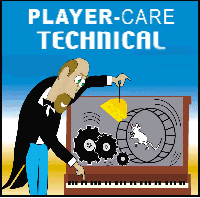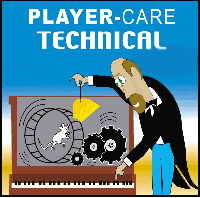
|

|

|

|

|

|
| Home | Manuals | Supplies | Search | Consult | Contact | Testing | Service |


Adjusting |
|
Adjusting Air Motor Valve Timing Standard Player Action slide valves should be adjusted so that the slider uncovers the port to the pneumatic with about 1/16-inch clearance above the opening. The adjustment needs to be close, but is not something that needs to be measured with ruler by any means. You can certainly eyeball it. If the crankshaft is straight, and the sliders are adjusted correctly and the motor still does not run smoothly on low vacuum, it is probably leaking elsewhere. I refer you to my article in the MMD Archives regarding restoring the Standard Pneumatic Co. player action wind motor [000818 MMDigest].
John D. Rutoskey - Automatic Music Machines By John A. Tuttle Hi All, Most men (and some women) understand why a spark plug is fired prior to top-dead-center (TDC). However, in an air motor the vacuum must be applied to each bellows shortly after the camshaft lobe for each bellows passes TDC. The further past TDC that the vacuum is applied, the lower the torque will be. If the vacuum is applied before TDC, the air motor will have a noticeably jerky nature. The easiest way to insure that the vacuum is applied shortly after TDC is to apply a medium level of vacuum (15") to the motor and then hold the camshaft with your hand, preventing it from turning. Then, allow the camshaft to turn very slowly and watch each bellows as its associated slider valve moves over its associated vacuum port. As the cam lobe for each bellows passes TDC you can see the bellows cloth react to the applied vacuum. Then adjust the slider (up or down) so that the bellows 'pulls' the camshaft 'forward'. Then, allow the camshaft to move 180 degrees and check to make sure that the atmosphere is allowed to enter the bellows before the next bellows starts 'pulling' the camshaft 'forward' Another thing to bear in mind is that if you get the 'start' point of each bellows too close to TDC, the felt bearings in the connecting rod will wear out much faster. I realize that the term 'shortly' is not very precise. Frankly, I've never attempted to measure the actual number of degrees past TDC that produces optimum performance. I imagine there is such a number, but I've never seen it in print in any reference material. Most technical literature relates the optimum position of the slider to the physical location of the vacuum supply port, which varies from manufacturer to manufacturer. With a little bit of trial and error, you'll find the optimum timing. I do know that a well timed (and well rebuilt) air motor will operate smoothly with the main vacuum hose moved away from the supply flange as much as 3/4", if the supply vacuum is about 20". It should work well if 2" of vacuum is applied directly to the vacuum supply port.
More in depth information appears in the web page at: By Ray Fairfield When I had timed the air motor in my last restoration, I tested it with a vacuum cleaner, holding the vacuum hose an inch or so away from the air motor suction tube. I'd adjust the distance from the vacuum cleaner hose to the suction hose until I got the vacuum so low that the air motor would just "creep", barely moving. I was dismayed that the air motor appeared jerky. No way I could make it smooth, no matter what I did. I finally decided that my test technique was flawed, because if I just sucked on the air motor suction line, very lightly, the air motor was absolutely smooth, even at the slowest speeds. The difference in techniques is that the former method is not a positive displacement technique. When you suck on the suction with no leakage path, the motor response is smooth. The message here is that the way you test your air motor affects how it performs.
Ray Fairfield By Craig Brougher Gerry Ceccarini was asking if anyone has a method for timing a Standard Air Motor, and Robbie wrote to me, asking if I would answer this one. To date, my new address has not yet been posted back to the MMD mailing list, so I was not aware that this newsletter was still operating. At any rate, I have a method, but it won't work if there is something wrong, so let's first go through a checklist.
Let's say that everything in the air motor is perfect. That means: 1. When the crank runs, the center doesn't wobble even faintly (it's not bent). 2. The 5 bellows are each perfectly tight and open to a span slightly greater than the crank throw so the cloth doesn't tighten when fully open. 3. Each bellows is perfectly limber and isn't different from its neighbor (not hinge-bound). 4. The glue joint at the manifold body is perfectly tight. 5. The slides and sliders are sanded true, flat, and without air seepage (sometimes also caused by old cloth covering), and the slider guides are close but don't bind. 6. As the sliders move, they do not twist or lift off the slide (as is sometimes caused by oversize leather nuts binding between the pallet and the stem). 7. All moving centers are free but not loose and sloppy. These are the most likely problems, and of the list I would say #3 is the most common. To test for #3, remove the crank arm from the bellows and very gently try to feel resistance. The Standard Player Action motor is so sensitive when properly restored that it can actually operate slowly through a #70 brass bleed cup. Now, to adjust such a motor, you gently suck on the supply, keeping a constant friction on the crank with your fingers as it turns. As certain bellows just reach TDC (top dead center) ready to go over center, you will notice that there is a weakness or hesitation, compared to others. That is caused by a pallet which has not quite covered its exhaust hole. So raise the pallet with its leather nuts to cover the hole when it's at it's highest point. You will notice that any air motor must be timed, and some motors use just a little more advance than others do. To make a smooth-running reciprocating motor like this, each pallet must be advanced just a hair. Now if you really want to see what you're doing, don't cover the pallets until last. Use clear packing tape. That way, you can see when the inside edge of the pallet top is even with the bottom of the exhaust hole. So the first adjustment is just to set them all mechanically at this point by eyeball. Then put the motor on a constant source through a restriction, at very low pressure -- like, say, 3" or less -- and at some point it will start to lope. The lope will be the open bellows which is weakest to get over TDC. Keep advancing its pallet upward until you even out the rotation.
Craig Brougher |

![]() ..To
The Top of this Page . . . . . . . . . . .
..To
The Top of this Page . . . . . . . . . . . ![]() ..To The HOME Page
..To The HOME Page
|
Since "Player-Care" is an internet business, I prefer that we correspond via E-Mail (click here to fill out the 'Request Form'). However, if I'm not in the middle of some other activity, you can reach me at 732-840-8787. But please understand that during the hours from 8AM-5PM EST (Mon-Sat), I'm generally quite busy. So, I probably won't answer the phone. If you get the answering machine, please leave a detailed message stating the reason for your call. Also, repeat your name and phone number clearly and distinctly. By necessity, I prioritize everything in my life. And, if you call and just leave your name and number, and ask me to call you back, it might be a day or two before I return your call. Why? Because I don't know why you want me to call and I might not be prepared to assist you in an effective and efficient manner. If you leave me an E-Mail address (which I prefer), spell it out phonetically. The more you do to help me, the more I can help you in return. Don't rush. You have four minutes to record your message. |
|
407 19th Ave, Brick, NJ, 08724 Phone Number 732-840-8787 (Voicemail Only, No Texts) |
